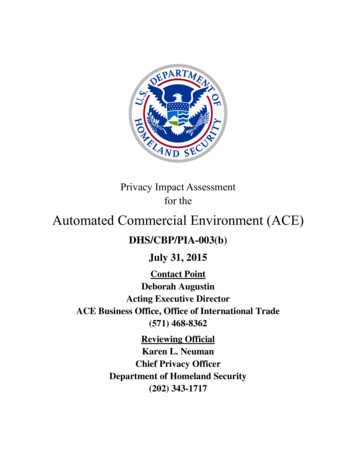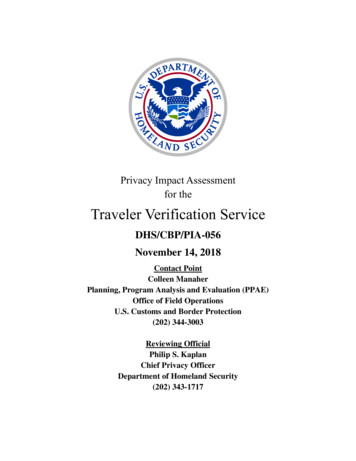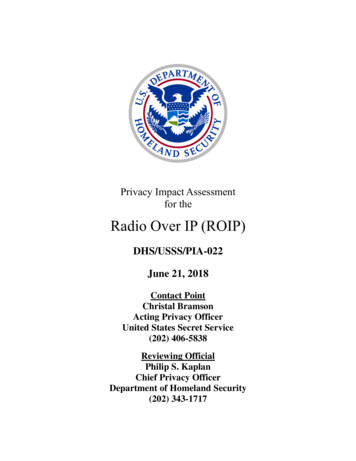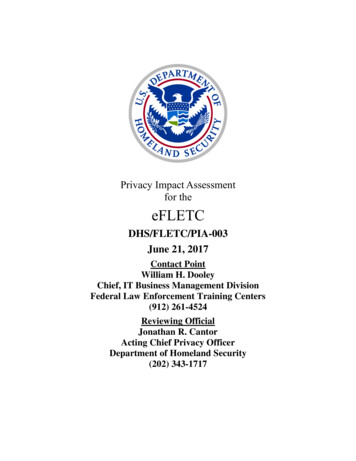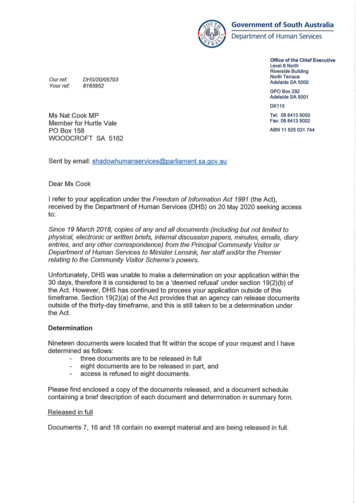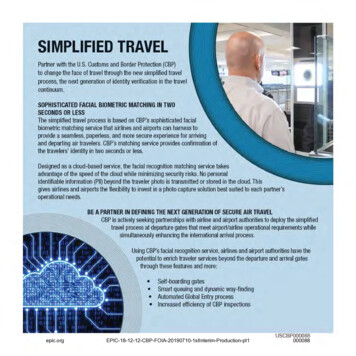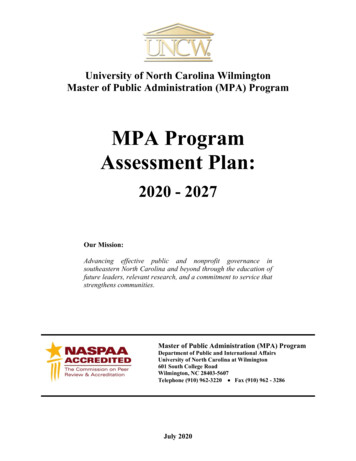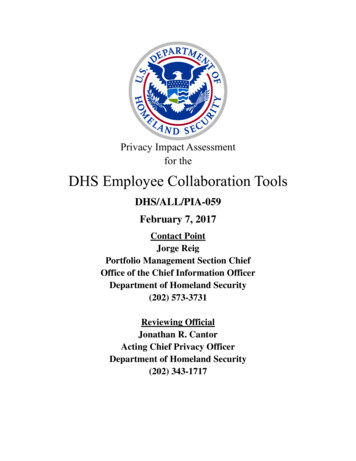
Transcription
Privacy Impact Assessmentfor theCentralized Area Video SurveillanceSystemDHS/CBP/PIA-014(a)June 29, 2018Contact PointColleen ManaherOffice of Field OperationsU.S. Customs and Border Protection(202) 344-3003Reviewing OfficialPhilip S. KaplanChief Privacy OfficerDepartment of Homeland Security(202) 343-1717
Privacy Impact AssessmentDHS/CBP/PIA-014(a)Centralized Area Video Surveillance SystemPage 1AbstractThe Centralized Area Video Surveillance System (CAVSS) — a system of camerasand separate microphones recording video and audio, respectively — furthers the Departmentof Homeland Security (DHS) U.S. Customs and Border Protection’s (CBP) mission bycollecting and maintaining video images and audio recordings of persons involved in anyincidents or disturbances related to DHS/CBP law enforcement at the border, includinginspection areas, while seeking entry or admission into the United States. CAVSS usesinformation technology to collect, maintain, and disseminate personally identifiableinformation (PII) in the form of video and audio recordings. CBP previously published aPrivacy Impact Assessment (PIA) discussing the use of CAVSS at land border locations. CBPis updating and reissuing this PIA in full to provide notice of the widespread deployment ofCAVSS throughout the CBP enterprise.OverviewThe fundamental mission of CBP is to safeguard America’s borders while enablinglegitimate trade and travel. In support of this mission and to enhance border security, CBPmaintains a series of Closed Circuit Television (CCTV) cameras and microphones in andaround various CBP facilities. CAVSS uses these CCTV cameras and microphones to collectvideo images and audio recordings that may contain PII at these locations. None of the CCTVcameras have audio recording capability; instead, separate microphones are installed near thecameras, or connect into the feed of a camera. The microphones are installed at every placewhere CBP regularly interacts with the public (e.g., a primary inspection lane); but not everycamera necessarily has a microphone installed nearby. For cameras with associatedmicrophones, CAVSS software combines the audio and video recording onto a digital videorecorder (DVR). Select analog cameras and DVRs must meet stated hardware designrequirements, which requires them to be in close proximity to each other. For cameras withassociated microphones, CAVSS software records the audio and video feeds separately on aNetwork Video Recorder (NVR), which uses mass storage devices and multiple arrays of harddrives. However, live and recorded data from audio and video can be monitoredsimultaneously. Archives are system files of video and audio recordings exported from CAVSSand stored on external devices particularly for playback purposes in court and other situations.In addition to enhancing border security, CAVSS imagery and audio recordings arealso routinely used to support various CBP missions, administrative functions, and judicialproceedings. Video and audio recordings from CAVSS cameras and microphones arenecessary to maintain the security of the physical premises and integrity of personnel employedtherein, to provide a record of any incidents or disturbances involving the traveling publicrelated to the inspection processes, to enforce maritime and air travel regulations, to assist with
Privacy Impact AssessmentDHS/CBP/PIA-014(a)Centralized Area Video Surveillance SystemPage 2law enforcement investigations and prosecute persons apprehended for violation of criminallaws, and to assist in adjudicating traveler complaints.CAVSS cameras in primary inspection lanes and those CAVSS cameras that employfixed and pan/tilt/zoom capabilities at CBP facilities are primarily focused on traveleridentification. In support of that objective, CBP uses audio recording at port locations wherethe traveling public interacts with CBP personnel. The audio recording from CAVSSmicrophones can collect a person’s verbal statement of his or her name, which is combinedwith the images collected by the CAVSS cameras for traveler identification. There is no textualPII stored in CAVSS, and PII captured by CAVSS audio/video cannot be electronicallysearched, queried, or analyzed. For example, at the current time, facial recognition technologyis not deployed on the video in CAVSS.Only if there were microphones installed with a camerawould audio be available for the respective video recordings. During the surveillance of anindividual’s presence at a CBP facility and interview of applicants for entry or admission intothe United States, an individual’s actions and utterances may be collected and stored byCAVSS cameras and microphones. This information may include an individual’s name, dateof birth, citizenship, port of entry, method of entry, vehicle information, date of entry, time ofentry, secondary inspection (including the incident that required a secondary inspection), anda record of items found during inspection when captured by a microphone or in view of acamera.Some ports are known as “limited hour” or non-24-hour port locations because thehours only correspond to the workday. The CAVSS cameras and CAVSS microphones at theselocations focus on threat detection and officer response. CAVSS cameras and CAVSSmicrophones allow CBP to efficiently monitor non-24-hour CBP facilities without requiringCBP Officers to be physically present, affording the opportunity to view and listen to real-timeevents at distant CBP facilities. Both 24-hour and non-24-hour ports are networked across theCBP Wide-Area Network (WAN) to a Centralized Area Security Center (CASC), where CBPofficers can remotely monitor the networked facilities 24 hours a day. At limited hour or non24-hour ports, CAVSS cameras on the perimeter incorporate low-light technology coupledwith motion detection sensors. At 24-hour ports, CAVSS cameras incorporate a fullcomplement of low-light digital imagery, some of which have motion detection capabilities.CAVSS cameras used at port perimeters are typically day/night cameras due to insufficientlighting, and may be enhanced with infra-red lighting. Additionally, U.S. Border Patrol(USBP) uses CAVSS thermal cameras, which detect images based on heat signatures, andCAVSS perimeter-out cameras at certain locations.The CAVSS perimeter-out cameras USBP uses may record images up to two milesfrom a CBP facility, but these longer range CAVSS cameras do not include a CAVSSmicrophone to record any sound with the images the CAVSS camera captures. USBP requiresvideo information from CAVSS perimeter-out cameras to detect activities away from a CBP
Privacy Impact AssessmentDHS/CBP/PIA-014(a)Centralized Area Video Surveillance SystemPage 3facility that pose a threat to border security. For example, a CAVSS perimeter-out cameracould alert USBP to a person leaving a vehicle headed toward a CBP facility, as that personmay be trying to avoid detection in case CBP stops the vehicle. These perimeter-out CAVSScameras are in fixed positions meant to survey a large area far away from a CBP facility, asopposed to the CAVSS cameras capable of following individuals in smaller CBP facilities.There is also no signage in the areas recorded by these longer range cameras informingindividuals that CAVSS cameras are recording; the only signage for any CAVSS recording isat facilities where CBP interacts closely with individuals. This allows CBP to efficientlymonitor non-24-hour CBP facilities without requiring CBP Officers to be physically present,affording the opportunity to view and listen to real-time events at distant CBP facilities. Both24-hour and non-24-hour ports are networked across the CBP WAN to a CASC, where CBPofficers can remotely monitor the networked facilities 24 hours a day.In its standard configuration, CAVSS retains video and audio for 90 days on aDVR/NVR with the exception of recordings deemed to have law enforcement significance andretained for longer periods of time. The collection and storage of PII is limited to recordedaudio utterances captured by a CAVSS microphone or visible images discernible via a CAVSScamera. There is no textual PII stored with the video or audio data in CAVSS. Stored videoand audio data can only be queried by camera location and the data/time stamp on therecording, and PII captured by CAVSS cameras or CAVSS microphones cannot beelectronically searched, queried, or analyzed. Audio or video captured by CAVSS cameras orCAVSS microphones will reside on the CAVSS servers and is automatically overwritten after90 days, unless the PII recorded is part of an incident.When CAVSS cameras or CAVSS microphones record images or audio of an incident,the relevant recordings will be copied, associated with a case file for the incident, and governedby the system of records notice (SORN) relevant to the incident’s case file, (see Section 1.2).Video and audio files in CAVSS archives that have been designated as Significant EventMedia, 1 because they depict a significant event, are saved on a disk, which is prominentlymarked “For Official Use Only” (FOUO). Significant events may include: natural disasters,weather-related incidents, intrusions, fires, tampering with equipment, and unlawful activity.Marked disks are stored in a locked, secure container in a secured area either onsite, or at thelocal CASC. None of the disks are marked with any PII or other identifiers. Only users with1Significant Event Media are retained for six months, or until the close of the case associated with the event,whichever is later. If the video or audio is needed for a law enforcement case, the video or audio will be linkedto the necessary PII and maintained consistent with the relevant enforcement system of records. The video andaudio from CAVSS cameras and CAVSS microphones may become associated with an individual such that it isretrieved by a personal identifier and will be covered by a DHS SORN based on the type of incident and thecontext for the retrieval of information (e.g. physical/personnel security or border security and enforcement).Significant Event Media are retained for six months, or until the close of the case associated with the event,whichever is later. If the video or audio is needed for a law enforcement case, the video or audio will be linked
Privacy Impact AssessmentDHS/CBP/PIA-014(a)Centralized Area Video Surveillance SystemPage 4prior authorization have access to the locked DVRs/NVRs and the marked disks in lockedcontainers.Section 1.0 Authorities and Other Requirements1.1What specific legal authorities and/or agreements permit anddefine the collection of information by the project in question?The data collected by CAVSS is generally authorized by CBP’s general statutoryauthority, which includes the Homeland Security Act of 2002, Public Law 107-296, Section1512, 116 Stat. 2310 (November 25, 2002); the Immigration and Nationality Act, including 8U.S.C. §§ 1222-1223, 1225, and 1357, implemented in accordance with the regulations setforth in 8 CFR § 287.5; various customs statutes, including 19 U.S.C. §§ 482, 1433, 1459,1461, 1499, 1581, 1582, 1644; 6 U.S.C §§ 202, 211, 231; and agriculture laws, including 7U.S.C. §§ 8303, 8304, 8307.Further, 40 U.S.C. § 1315 authorizes DHS to protect the buildings, grounds, andproperty owned, occupied, or secured by the Federal Government and its agencies, as well asthe persons on the property. In protecting that property and those persons in and around CBPfacilities, CBP is acting in its official capacity to secure the border and has authority to recordaudio information in CAVSS pursuant to 18 U.S.C. § 2511(2)(d).In addition, the Physical Security Criteria for Federal Facilities, An InteragencySecurity Committee Standard Report issued on April 12, 2010 (and successor documents)require CCTV monitors for the majority of federal buildings, including those at CBP Facilities,from low security requirements to very high. The DHS Physical Security Construction andEquipment Handbook, May 27, 2010, also requires CCTV for the protection of DHSHeadquarters sites.1.2What Privacy Act System of Records Notice(s) (SORN(s))apply to the information?Video and audio in CAVSS are not retrievable by a personal identifier while archivedon the DVRs/NVRs or in storage, and therefore do not constitute a system of records under thePrivacy Act of 1974. However, video and audio from CAVSS cameras and CAVSSmicrophones may become associated with an individual such that it is retrieved by a personalidentifier and will be covered by a DHS SORN based on the type of incident and the contextfor the retrieval of the information. For incidents related to the physical access to a CBPfacility, those are covered under the DHS/ALL-024 DHS Facility and Perimeter AccessControl and Visitor Management SORN 2, or DHS/ALL-025 Law Enforcement Authority in275 Fed. Reg. 5609, Feb. 3, 2010.
Privacy Impact AssessmentDHS/CBP/PIA-014(a)Centralized Area Video Surveillance SystemPage 5Support of the Protection of Property Owned, Occupied, or Secured by the Department ofHomeland Security SORN. 3 In the event that those incidents relate to an internal affairs action,these video and audio recordings may also be maintained pursuant to DHS/ALL-023Department of Homeland Security Personnel Security Management. 4For activities related to border security, video or audio associated with a lawenforcement activity will be linked to PII maintained in reports and records residing in theassociated case file system of records including, DHS/CBP-011 U.S. Customs and BorderProtection TECS 5, DHS/CBP-023 Border Patrol Enforcement Records (BPER) 6, andDHS/CBP-024 Intelligence Records System (CIRS) 7. These systems provide electronic casemanagement capability to support DHS law enforcement activities and when appropriate, thecase status will be updated to reflect the existence of video maintained external to the systemto support the narrative remarks contained in the system.1.3Has a system security plan been completed for the informationsystem(s) supporting the project?A system security plan was completed as part of the process to renew the Authority toOperate (ATO) which is expected to be obtained on August 7, 2018.1.4Does a records retention schedule approved by the NationalArchives and Records Administration (NARA) exist?No. If CAVSS information is incorporated into a particular system of records, theschedule approved for that system of records would govern the retention of the CAVSS data.1.5If the information is covered by the Paperwork Reduction Act(PRA), provide the OMB Control number and the agencynumber for the collection. If there are multiple forms, includea list in an appendix.CCTV and CAVSS audio/video recordings are exempt from the Paperwork ReductionAct (44 U.S.C. § 3510) because the recordings constitute a passive collection of informationon members of the public.382 Fed. Reg. 27274, June. 14, 2017.75 Fed. Reg. 8088, Feb. 23, 2010.573 Fed. Reg. 77778, Dec. 19, 2008.681 Fed. Reg. 72601, Oct. 20, 2016.782 Fed. Reg. 44198, Sept. 21, 2017.4
Privacy Impact AssessmentDHS/CBP/PIA-014(a)Centralized Area Video Surveillance SystemPage 6Section 2.0 Characterization of the InformationThe following questions are intended to define the scope of the information requested and/or collected,as well as reasons for its collection.2.1Identify the information the project collects, uses, disseminates,or maintains.CAVSS collects and temporarily stores video images and audio recordings of everydayactivity in and around CBP facilities as part of the background data that is collected to observeand to record any incidents and disturbances. If no disturbances or incidents are observed, theimages and audio are overwritten after 90 days as subsequent recordings overwrite the pastCAVSS audio and video data after the designated timeframe. PII that may be stored on thevideo (if discernible by the camera) or audio (if captured by the microphone) recordings mayinclude: Name; Date of birth; Citizenship; Physical description; Verbal statements; Port of Entry; Method of entry, including vehicle information; Date of entry; Time of entry; and A record of items found during the inspection.Information stored by CAVSS longer than 90 days includes audio and video images ofindividuals involved in incidents or disturbances subject to legal holds or executive/judicialorders, including DHS/CBP inspection at a CBP facility, images/audio of the individualescorted into, inside, and out of the inspection areas of the port of entry, video images andaudio of activity at the port perimeter at non-24-hour ports, and, in certain instances, videoimages of activity beyond the port perimeter. For those not involved in such incidents ordisturbances (the vast majority of the public at the border), CAVSS will still collect audio andvideo data that CAVSS will automatically overwrite after 90 days.Files may be marked with date/time stamps, camera or microphone location, andrestriction markings (“FOUO”). Responses to critical incidents, intrusions, or safety-related
Privacy Impact AssessmentDHS/CBP/PIA-014(a)Centralized Area Video Surveillance SystemPage 7incidents captured by CAVSS that necessitate notification of incidents outside DHS to otherfederal, state, or local law enforcement authorities will be recorded in paper logs that containthe date, time, location, telephone number, and the officer’s name and rank. These paper logsare not indexed to be searched by any criteria other than date and time stamps.2.2What are the sources of the information and how is theinformation collected for the project?Video images of the areas surrounding CBP facilities, and the traveling public alongwith accompanying audio utterances are collected using CAVSS cameras and separate CAVSSmicrophones at CBP facilities in the United States.2.3Does the project use information from commercial sources orpublicly available data? If so, explain why and how thisinformation is used.No commercial or publicly available data is used.2.4Discuss how accuracy of the data is ensured.Video and audio are recorded in real time to maintain a factual record of events. Anauthorized user in the CASC can adjust CAVSS cameras and CAVSS microphones to improvethe video images and audio recordings (e.g., resolution and microphone volume). Oncerecorded, the records are kept in a secure CBP facility where multiple forms of authenticationare required before entering the facility, including badges, locked doors, and keyed entries.Users of CAVSS are required to log into a CBP workstation using a CBP identification numberand valid password, and are then required to log into CAVSS itself. Additionally, authorizedusers of CAVSS must successfully complete training as described in Sections 3.4 and 8.2.2.5 Privacy Impact Analysis: Related to Characterization of theInformationPrivacy Risk: There is a privacy risk that information may be collected beyond thescope of CBP’s mission of border security.Mitigation: The nature of CBP’s mission requires the collection of information relatingto the security of the nation’s borders. The video and audio information captured at CBPfacilities record current inspection and law enforcement activities that are relevant andnecessary to maintain the security of the physical premises, the integrity of the personnelemployed therein, and to provide a record of any incidents or disturbances involving thetraveling public related to the inspection processes.Privacy Risk: There is a privacy risk that an individual’s image is collected as part ofan incident about someone else.
Privacy Impact AssessmentDHS/CBP/PIA-014(a)Centralized Area Video Surveillance SystemPage 8Mitigation: This risk cannot be fully mitigated given that the CAVSS equipment isstationary and focused on designated spaces and the individuals who enter these areas. Anindividual’s image may be captured by CAVSS as part of an incident or as part of a lawfulactivity, however CBP will not identify or attempt to identify any individuals from CAVSSrecordings unless it is relevant and necessary for law enforcement investigations. Any imagesnot associated with incidents will be overwritten after 90 days. There is no textual PII storedin CAVSS, and PII captured by CAVSS audio/video cannot be electronically searched,queried, or analyzed. For example, at the current time, facial recognition technology is notdeployed on the video in CAVSS.Privacy Risk: There is a privacy risk that CAVSS collects more information thanneeded because a greater population is impacted by the additional deployments throughoutCBP.Mitigation: This risk is minimized because the business (or law enforcement)justification for collection of the data, records retention requirements, use and redress relatedto video and audio monitoring are unchanged. It is only that a greater volume of recordingswill be collected due to wider usage of the equipment. Additionally, while equipment isdeployed in detention facilities, there are restrictions on the collection of video and audio inprivate areas (i.e., showers, bathrooms) of these detention centers.Section 3.0 Uses of the InformationThe following questions require a clear description of the project’s use of information.3.1Describe how and why the project uses the information.The video images and audio recordings captured by CAVSS cameras and CAVSSmicrophones are used for port surveillance and to enhance border security. Video and audiofrom CAVSS is necessary to maintain the security of the physical premises and integrity of thepublic and personnel present therein, to provide a record of any incidents or disturbancesinvolving the traveling public, to assist with law enforcement investigations and theprosecution of persons apprehended for violation of criminal laws, and to assist in theadjudication of complaints. If notification of the incident is necessary to a federal, state, orlocal law enforcement authority outside of DHS, CBP will record in paper logs the date, time,location, telephone number, and the name and rank of the officer notified. Situations requiringnotification include critical incident intrusions or safety related incidents captured by CAVSScameras and CAVSS microphones. For information release procedures, please see section 3.3.
Privacy Impact AssessmentDHS/CBP/PIA-014(a)Centralized Area Video Surveillance SystemPage 93.2Does the project use technology to conduct electronic searches,queries, or analyses in an electronic database to discover orlocate a predictive pattern or an anomaly? If so, state howDHS plans to use such results.No. CAVSS captures and stores video and audio on the DVRs/NVRs that record andindex the data by date, time, and camera in audio/video files that can be viewed by authorizedCBP officials. In cases in which CAVSS imagery and audio recordings are used to address anincident, by, for example, supporting administrative and judicial proceedings, the audio/videofiles may be saved onto a digital video disk (DVD).3.3Are there other components with assigned roles andresponsibilities within the system?Access to the CAVSS system is restricted to CBP personnel. No other DHS componentrepresentatives have assigned roles and responsibilities within the system. However, consistentwith their enforcement jurisdiction, other DHS components (and other law enforcemententities) may request surveillance video or audio records in support of their enforcementmission. In the event that archived video footage or audio recordings from an event needs tobe retrieved for evidence or investigation, the requesting DHS component (e.g., U.S.Immigration and Customs Enforcement (ICE)), must coordinate with authorized CBPpersonnel, demonstrating an official “need to know” before archived data is released.3.4Privacy Impact Analysis: Related to the Uses of InformationPrivacy Risk: Video and audio recordings will be used in a manner inconsistent withtheir original purpose of collection.Mitigation: In furtherance of CBP’s mission to secure the border, video and audiosurveillance recordings are used to ensure the security of the physical premises at CBPfacilities, the integrity of the personnel employed therein, and to provide an evidentiary recordof any incident or disturbance at a CBP facility including in areas used for DHS/CBPinspections at a CBP facility, inspection areas of the port of entry, the port perimeter at non24-hour ports, and, in certain instances, beyond the port perimeter. To ensure that therecordings are accessed and used in a manner consistent with their original purpose ofcollection, all video and audio recordings are stored on DVRs/NVRs that are located in eitherlocked cabinets/racks or in a secured LAN room. The racks containing the DVRs/NVRs areinstalled in CBP-controlled access areas that may be entered only by authorized personnel. Togain access to (live or recorded) video or audio, authorized personnel must have prior signedauthorization from their supervisors and Port Directors/Chiefs/Directors (via User AccessRequest Forms). The forms will also identify which camera locations can be accessed and what
Privacy Impact AssessmentDHS/CBP/PIA-014(a)Centralized Area Video Surveillance SystemPage 10actions are permitted with the content. CAVSS user access is reassessed annually. These usersmust also have a valid “need to know” and have been trained on the proper use of the system,including the two-factor authentication process, before they may directly access the systemand specific recordings. CBP Directive No. 5620-003 (dated June 2017) provides guidance onaccess, recordkeeping, disclosure and response protocols related to CAVSS.Additionally, all authorized users must take and successfully complete the CBP ITRules of Behavior Training in addition to the mandatory Privacy Act training annually requiredfor all CBP employees and contractors. As an additional control to ensure use limitation, videoand audio recordings that have been designated as Significant Event Media are saved on diskswhich are prominently marked “For Official Use Only” (FOUO) and do not contain any othermarkings except date and time stamps. Such marked disks are stored in a locked, securecontainer in a secured area either onsite, or at the local CASC. Only users with priorauthorization have access to the locked DVRs/NVRs and the marked disks in lockedcontainers. Significant events may include: natural disasters, weather-related incidents,intrusions, fires, tampering with equipment, and unlawful activity.Section 4.0 NoticeThe following questions seek information about the project’s notice to the individual about theinformation collected, the right to consent to uses of said information, and the right to decline to provideinformation.4.1How does the project provide individuals notice prior to thecollection of information? If notice is not provided, explain whynot.This PIA provides notice to the general public as to the collection and use of recordedimages and audio information. With regard to travelers, signage is posted throughout CBPfacilities that notify the public that video and audio recording devices are in use. Per CBPprocedural guides regarding video and audio surveillance, twenty-four (24) hour closed circuittelevision (CCTV) surveillance and recording are required at all locations. The requirementswill depend on assessments of the security level for each facility. That is, the quantity andplacement of these notices will vary across facilities. Time-lapse video recordings are alsohighly valuable as a source of evidence and investigative leads. Warning Signs advising of 24(twenty-four) hour surveillance serves to protect employees and facilities and notifies thepublic of collection of images and other information on them.The warning signs typically read as follows:NOTICE: 24 HOUR VIDEO AND AUDIO MONITORING ARE IN USE ATTHIS FACILITY
Privacy Impact AssessmentDHS/CBP/PIA-014(a)Centralized Area Video Surveillance SystemPage 11At CBP facilities along the southern border, the signage is printed in English andSpanish. At other CBP facilities located along the northern border, the signage is printed inEnglish and French. Additionally, notification or signage is prominently displayed at the sitewhere the cameras/microphones are deployed and operational to alert potential subjects of theirusage. Please see the Appendix for additional example signage.Notification signs are not posted outside the CBP facilities with perimeter-out CAVSScameras used by USBP that can record video of individuals — albeit with significantly lessresolution and tracking — up to two miles away. The large areas covered by longer rangeCAVSS cameras make the placement of signage covering all possible areas capable of beingrecorded almost impossible. Through publication of this PIA and signage at CBP facilities, theagency provides notice to the public that video and audio recording devices are in use.4.2What opportunities are available for individuals to consent touses, decline to provide information, or opt out of the project?Generally, the decision whether to travel internationally or to travel in the proximity ofanother country’s borders is a matter within the discretion of the individual. United States lawrequires individuals seeking to enter the country to identify themselves and demonstrateadmissibility to the United States, if applicable, and otherwise comply with other U.S. law.Inasmuch as the cameras and audio recording devices used at CBP facilities are continually inuse, there is effectively no mechanism for an individual to decline to provide information, optout of the project, or decline to consent to the uses of the information. The only way for anindividual to avoid the program is to not seek to approach a CBP controlled space that is at ornear a CBP facility housing CAVSS equipment.4.3Privacy Impact Analysis: Related to NoticePrivacy Risk: Individuals may not be aware that their actions and conversations arebeing record
The Centralized Area Video Surveillance System (CAVSS) — a system of cameras and separate microphones recording video and audio, respectively — furthers the Department of Homeland Security (DHS) U.S. Customs and Border Protection's (CBP) mission by collecting and maintaining video images and audio recordings of persons involved in any

